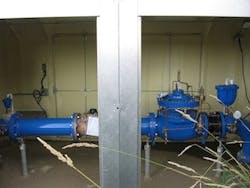A Common Good
The Millcreek Township Water Authority (MTWA) of Millcreek Township, Pa.—near Erie, Pa.—was created in 1974 to provide water to the rapidly growing Millcreek Township customer base. The MTWA purchased several small water systems, which have been upgraded and grown to 112 miles of pipeline ranging in size from 2 to 24 in., with ten pump stations to maintain water pressure, five water towers for storing a total of 5 million gal and one groundwater well. The water distribution system has elevation changes of about 400 ft and an average daily flow of approximately 2.5 mgd. With 7,300 customers and growing, it is essential that Millcreek Township continue to maintain an effective and reliable water system.
The problem
In recent years, growth in the Peach Street commercial district—the main shopping and dining area of Erie County—has taxed the capability of the MTWA's Peach Street Pump Station. This facility provides water to the neighboring communities of Summit Township and McKean Township, and its reliable operation is essential to all three communities. The MTWA retained the consulting firm of Hill Engineering Inc. to evaluate the future demands of the Peach Street pressure district and to develop a long-term plan to meet those needs. The Hill Engineering report recommended construction of a larger Peach Street Pump Station with greater capacity, as well as construction of more distribution system storage to meet fire demands. Construction of these improvements will take years to plan, design and build due to the multiple authorities and townships involved. Interim upgrades are essential to make it through the next few years.
During the planning process, the owners of the Millcreek Mall—the largest shopping center in the area—approached the MTWA, requesting to be connected to Millcreek's system to avoid costly repairs to its own private water tower, which was in need of upgrade. The MTWA's Peach Street Station could provide the mall with sufficient water to meet its daily demands, but the availability of adequate fire flow from the station could not be guaranteed.
The solution
The solution was to develop a reliable interconnection between the Millcreek system and the Summit Township system, so that the Summit Township Water Authority's (STWA) existing Waterview water storage tank could automatically backfeed into the Millcreek system in the event of a fire or loss of electric power at the MTWA's Peach Street station. A manually operated pressure-reducing valve (PRV) had been installed years before to provide such emergency backflow, but it was not considered to be completely reliable. In addition to being a single (non-redundant) device, the valve was located in a buried vault and its activation required an operator to be present to open a gate valve. With a pressure differential of about 100 psi at the interconnection point, an automatically operated, fail-safe PRV was needed to avoid damage in the event of valve failure.
“We considered putting two PRVs in line acting as a safety backup, but this added to the cost and doubled the maintenance required,” said Keith Malone, water operations superintendent of the MTWA. “When we heard about Singer Valve’s pressure-reducing valve with integral backup [PR-SM], it seemed to be the best solution.”
The PR-SM control valves are engineered to be used anywhere pressure-reducing valve failure is unacceptable. They have a second, independent operating system superimposed upon the standard primary system. Under normal pressure-reducing conditions, the primary pilot senses the downstream pressure through a connection at the valve outlet. Under flowing conditions, the pilot reacts to small changes in pressure to control the valve position by modulating the pressure above the diaphragm in the lower operating chamber. The downstream pressure is maintained at the pilot set point, which is adjustable.
Should the primary pilot system and/or main valve fail to control the downstream pressure, the independent backup pilot system will begin to operate; it controls the pressure above the diaphragm in the second operating chamber. The backup pilot is set slightly higher than the primary pilot. The forces now operating in the top chamber assume control of the inner valve assembly and maintain pressure-reducing control.
The secondary pilot continually senses the downstream pressure. Should there be a rapid rise in downstream pressure for any reason, the secondary pilot will respond quickly and will pressurize the top chamber. This will compliment the primary pressure-reducing controls and provide faster response.
“The double diaphragm valve gave us the confidence to make the interconnection and allow it to operate completely automatically,” said Hill Engineering’s Clayton J. Fails, P.E.
The results
Through interauthority cooperation, the MTWA purchased the materials, and because it was located in Summit Township’s system, the STWA installed the pressure-reducing valve in an aboveground heated enclosure for ease of maintenance and inspection. The installation took about two weeks to complete after the materials were at the site.
This project has allowed the MTWA to maintain water pressure to its customers and the Millcreek Mall continuously, even during power outages. The cooperation between the two authorities has shown that great things can be accomplished when people work together to solve critical problems.
